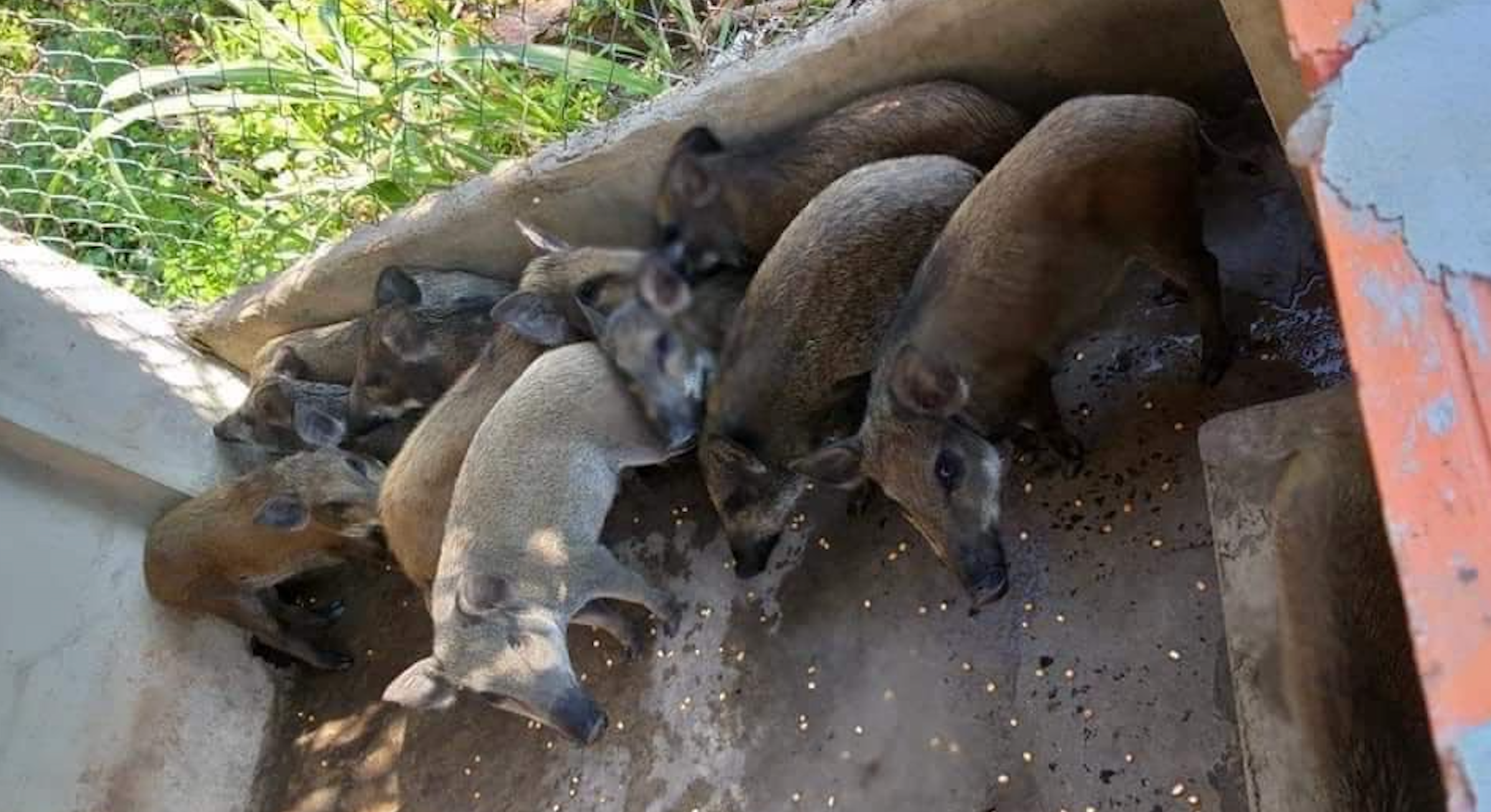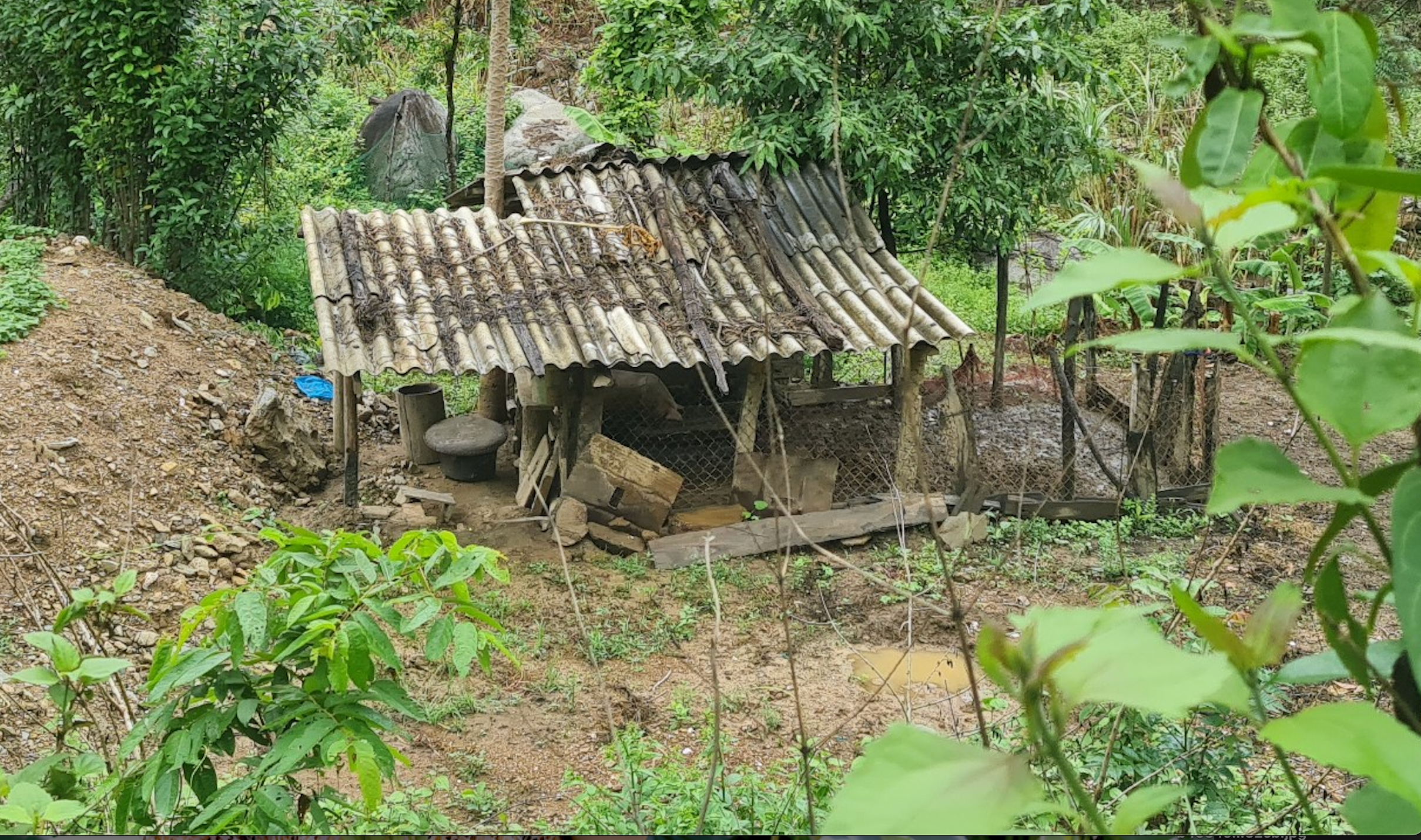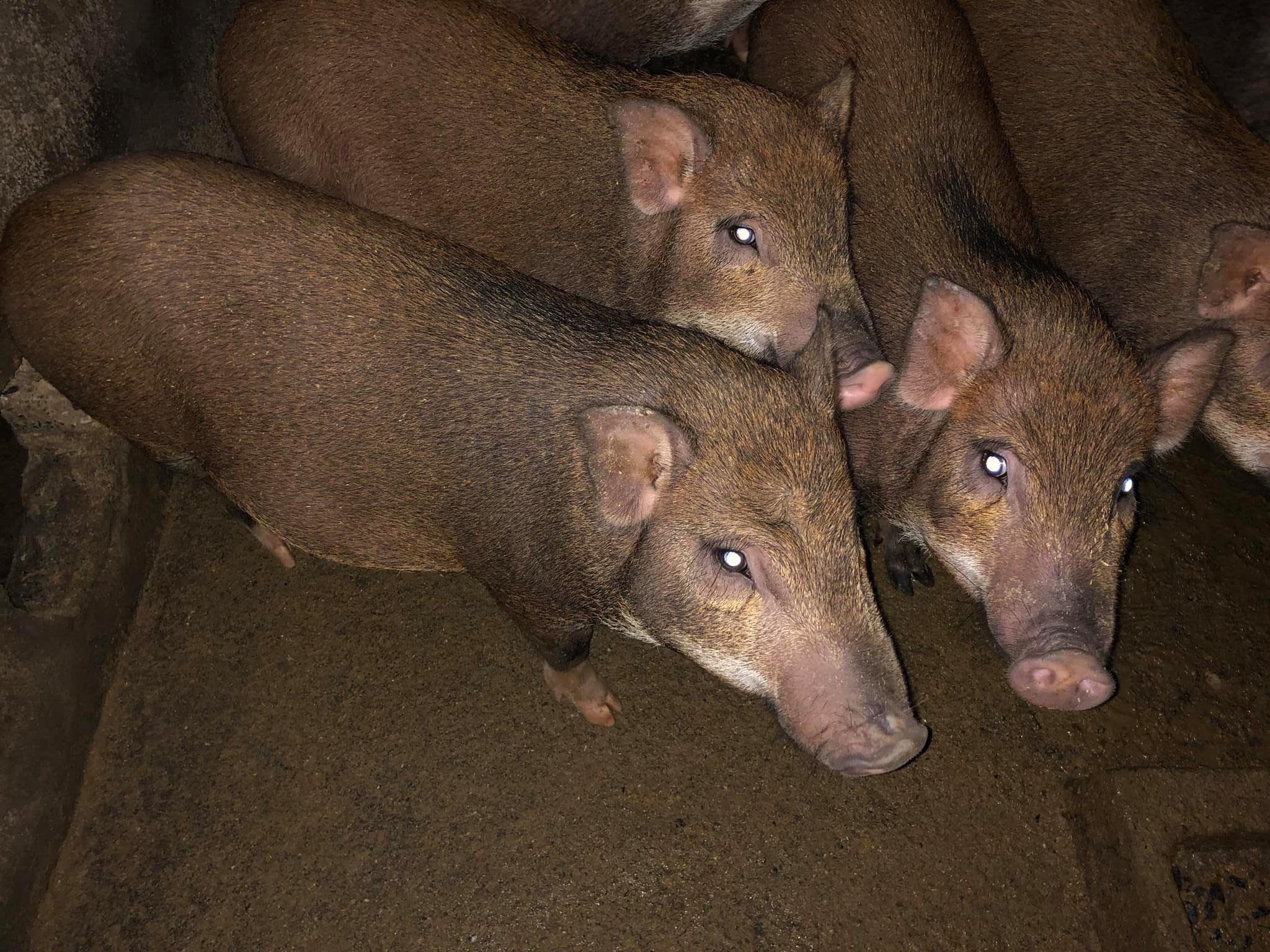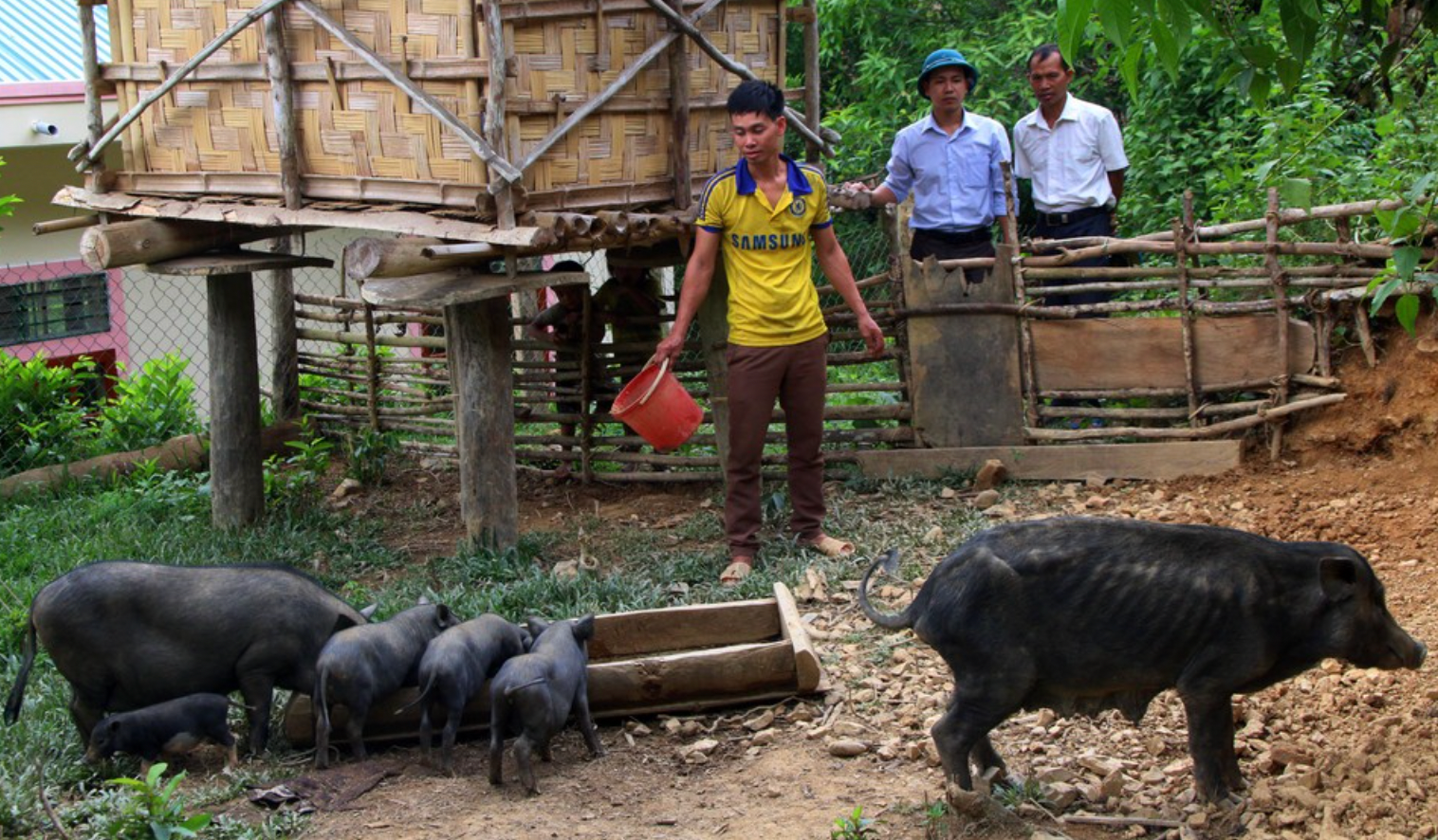Vietnamese
The "white" version of the native black pig
In the last days of June, in Ta Ca commune, Ky Son border district, the hot weather has made life in many villages more difficult. Mr. Hoa Van Quyet - Head of Sa Vang village, Ta Ca commune said that the village not only has difficulty with water resources, but also has failed in livestock and crop production due to the harsh weather.

“This year’s spring rice crop in Sa Vang village is low yielding and has reduced acreage. However, the biggest impact is that the village is now almost completely losing its native black pig breed,” Mr. Quyet worried.
Mr. Quyet said that the native black pig breed in Ta Ca commune in particular, and in Ky Son district in general, is quite small and takes a long time to grow, but the quality of its meat is much better than other pig breeds. “Native black pigs are mainly free-range around the production area. Some households keep them in captivity, but their main food is still vegetables, seeds, tubers such as cassava, corn, etc., so they have to be raised for a whole year before they can be sold.
Ms. Moong Thi Mun, a household that used to raise native black pigs, also expressed that in the past, every household in Sa Vang village raised pigs so that they would have food to celebrate the New Year. But for more than half a year now, since the end of 2022, the number of native black pigs of Sa Vang villagers can be counted on the fingers of one hand.
Asked about the reason, Ms. Mun replied: "Due to the epidemic". Talking more about this, the village chief Hoa Van Quyet said that the African swine fever epidemic at the end of 2022 almost "wiped out" the number of black pigs in Sa Vang village. In addition, in recent years, the weather has been complicated, from hot to cold, flash floods have caused many livestock deaths. In addition, the custom of letting buffalo, cows and pigs roam freely is also the reason for the decline in the number of pigs of the people.

Mr. Quyet's family alone had a herd of nearly 20 pigs that all died, and now the barn is abandoned. Many households in Sa Vang village are in a similar situation. Mr. Quyet added that the whole village has more than 80 households, and in the past every household raised native black pigs, but now only 2 households still keep about 5 native black pigs. In 2023, pig diseases still occur sporadically, and the risk is still high. These households are trying to take care of them, both worrying that the pigs will get sick and die, and that the pigs will not be able to reproduce, and the source of native black pigs will be lost completely.
Ta Ca commune Fatherland Front officer Moong Van Dao led us around a small dirt road, following the mountainside for about 4km to reach Na Nhu village.
Mr. Dao said that Na Nhu village is also suffering the same situation as Sa Vang, that is, the black pig herd almost died after the African swine fever epidemic last year. Now people have started to re-herd, but mainly buy white pigs from lowland districts to raise. "The native black pig breed in Ta Ca is scarce, the villages near Na Nhu currently have no one to sell" - Mr. Moong Van Dao said.
Efforts to preserve native livestock breeds
In My Ly commune, in some villages near the center such as Hoa Ly, Xieng Tam, Xang Tren, the supply of native black pigs is also scarce. The main reason is still the damage after the African swine fever epidemic from 2019, which has lasted sporadically until now.

Officials from the Department of Agriculture of the People's Committee of Ky Son district said that the African swine fever outbreaks from 2020 to now are still smoldering, so people are still very cautious about re-herding, especially with the native black pig breed. The outbreak that caused the most damage to the pig herd in Ky Son was in 2019, occurring in almost all communes and towns. Many villages and hamlets had their pig herds almost wiped out, including black pigs, such as Buoc village, Huoi Cang village in Bac Ly commune; some villages in Muong Ai, My Ly, Keng Du, Ta Ca, Huu Kiem, Bao Nam communes... At the time when the African swine fever outbreak was at its strongest, Ky Son had about 25,000 pigs.
Currently, the pig herd in Ky Son is about 28 thousand. In some communes such as Ta Ca, My Ly, Muong Ai, Muong Tip... although the native black pig breed is scarce, households are very cautious about buying pigs from other communes to raise, for fear of spreading the disease.
For poor families, the source of black pig breeds supported by border guards in coordination with the Provincial Farmers' Association for many years has become a source of livelihood to help many households escape poverty. However, in 2023, many border guards are also facing difficulties in building a source of black pig breeds to support people.
Major Nguyen Van Tam - Deputy Political Commissar of My Ly Border Guard Station said that due to the African swine fever outbreaks, the herd of native black pigs that the unit had invested in raising in cooperation with the Provincial Farmers' Association is no longer available. The unit is looking for a source of native black pigs to build up the herd to continue supporting the people.

An official of the Ta Ca Commune People's Committee also said that the entire commune is experiencing a shortage of native black pigs. Therefore, the commune is continuing to direct and support people to recover and rebuild their pig herds after being affected by African swine fever; at the same time, fully implementing disease prevention and control measures for livestock. In May, Ta Ca completed the vaccination of livestock and poultry in all villages.
The Ta Ca people's pig herd currently has more than 1,000 pigs, but they are mainly white-haired pigs, bought from other localities. Some households still have a few native black pigs and are trying to multiply their herds. The Commune People's Committee has sent staff to support people with techniques for caring for and preventing diseases for livestock, promoting the reproductive process for breeding, and preserving the source of native livestock breeds.
According to the report of the Provincial People's Committee, in 2023, African swine fever will continue to occur in many districts and towns. As of July 10, 2023, the whole province has had 23 outbreaks of African swine fever in 7 districts, cities and towns, causing 594 pigs to die, with a total weight of nearly 21 tons, and must be destroyed. There are still 2 outbreaks of African swine fever in Yen Thanh district waiting for the time to declare the end of the epidemic.